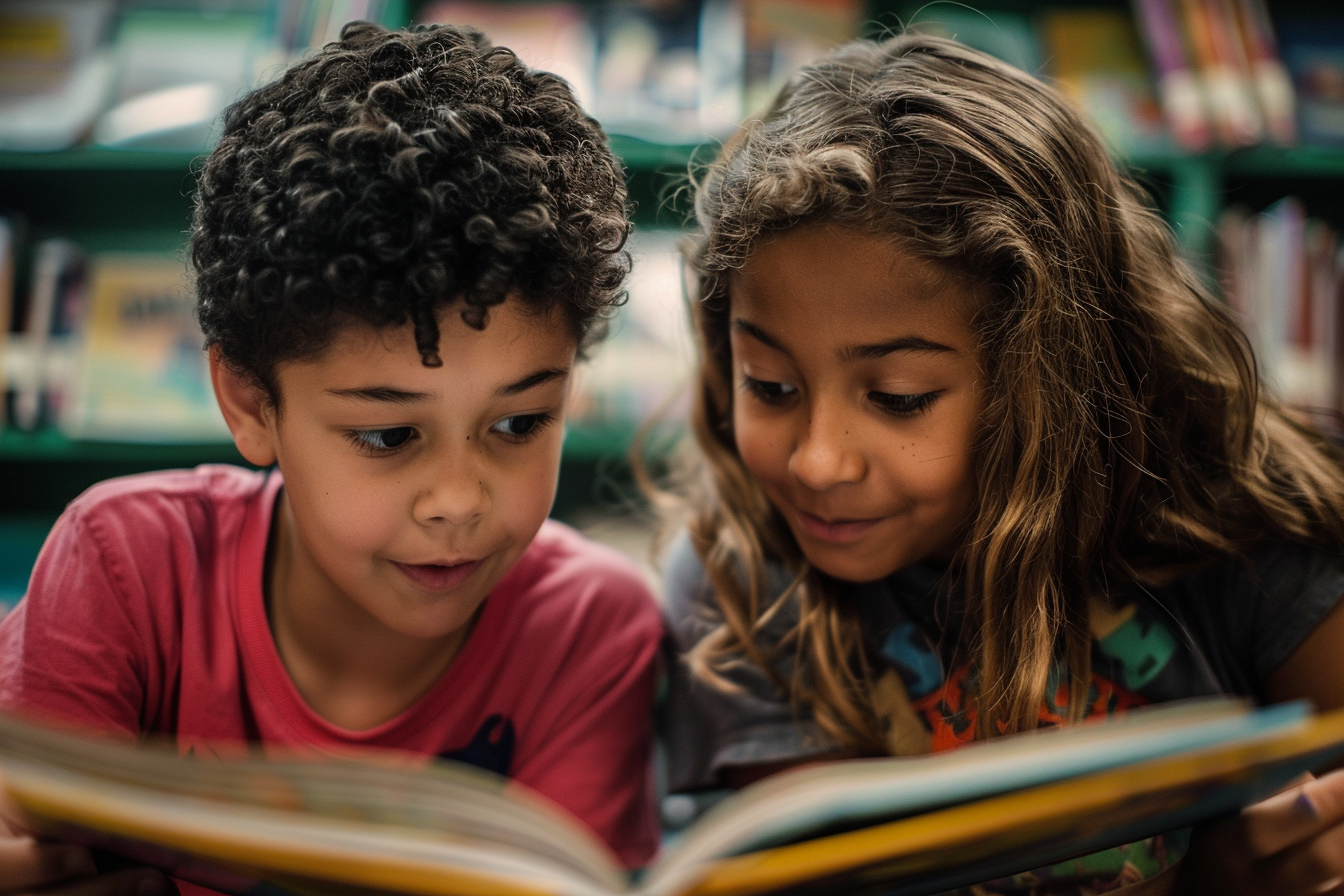The Benefits of Reading Buddies: Enhancing Student Literacy
Boost literacy with reading buddy programs—peer mentoring that sparks love of books, builds fluency, and strengthens classroom community.

Imagine a classroom buzzing with excitement as older students mentor younger ones, sharing the joy of reading and discovering new stories together. Reading buddies and literacy initiatives can transform this vision into reality, creating a dynamic and supportive learning environment. As literacy remains a cornerstone of academic success and personal development, these programs are more crucial than ever.
Reading buddies pair students of different ages or abilities, fostering mentorship and enhancing reading skills. Literacy initiatives, encompassing activities like book clubs and family reading nights, promote a culture of reading within the school and community. These programs not only improve reading proficiency but also build confidence, social skills, and a lifelong love for literature.
We will explore the benefits of reading buddies and literacy initiatives, practical steps for implementation, and inspiring case studies. Discover how these programs can revolutionize your classroom and empower your students to thrive in their educational journey. Dive in to learn more about fostering literacy through innovative and engaging approaches.
Understanding Reading Buddies and Literacy Initiatives
Reading buddies and literacy initiatives are programs designed to improve reading skills and foster a love of reading among students. Reading buddies typically pair older students with younger ones to read together, providing mentorship and enhancing literacy skills. Literacy initiatives encompass a wide range of activities aimed at promoting reading, such as book clubs, family literacy nights, and community reading events.
Historically, these programs have roots in educational practices that emphasize peer learning and community involvement. Over time, they have evolved to include structured approaches and diverse activities to meet the needs of various student populations. These programs are crucial in addressing literacy challenges and encouraging lifelong reading habits.
Enjoy science fiction? Check out my space books HERE on Amazon!
Implementing reading buddies and literacy initiatives in schools helps create a supportive learning environment where students can develop their reading skills and build confidence. These programs also foster positive relationships and social skills, contributing to a well-rounded educational experience.
Benefits of Reading Buddies and Literacy Initiatives
Reading buddies and literacy initiatives offer numerous advantages that enhance students' academic and personal growth. Here are some key benefits:
- Improved Reading Skills: Enhancing fluency, comprehension, and vocabulary through regular reading practice.
- Fostering a Love of Reading: Encouraging a lifelong passion for reading by making it enjoyable and accessible.
- Building Confidence and Social Skills: Developing communication and interpersonal skills through peer interaction and mentorship.
- Creating Positive Relationships: Strengthening bonds between students of different ages or abilities, fostering a sense of community.
- Enhanced Academic Performance: Supporting overall academic achievement by improving literacy, a fundamental skill.
- Cultural Awareness and Empathy: Exposing students to diverse perspectives and stories, promoting understanding and empathy.
- Parental and Community Engagement: Involving families and community members in literacy activities, enhancing support for students' learning.
These benefits highlight the importance of implementing reading buddies and literacy initiatives in schools. By fostering a love of reading and improving literacy skills, these programs contribute significantly to students' academic success and personal development.
Types of Reading Buddies and Literacy Initiatives
There are various types of reading buddies and literacy initiatives, each tailored to different educational settings and student needs. Here are some effective models:
- Cross-Age Reading Buddies: Pairing older and younger students for shared reading sessions. This model allows younger students to benefit from the guidance of their older peers, while older students reinforce their own reading skills and gain leadership experience.
- Peer Reading Programs: Students of the same age or grade reading together. These programs encourage collaboration and mutual support, helping students improve their reading skills in a comfortable and familiar environment.
- Community Involvement: Engaging local volunteers and organizations in literacy programs. This approach leverages community resources and expertise, providing students with diverse reading experiences and role models.
- Family Literacy Nights: Encouraging family participation in reading activities and events. These initiatives promote reading at home, involving parents and guardians in their children's literacy development and creating a supportive reading culture.
- Book Clubs: Organizing student-led book clubs where participants read and discuss books together. This fosters a deeper understanding of literature and enhances critical thinking skills.
- Reading Competitions: Hosting school-wide reading challenges to motivate students to read more books and improve their literacy skills. This adds a fun and competitive element to reading, encouraging students to set and achieve reading goals.
These types of reading buddies and literacy initiatives can be adapted to fit various educational contexts, providing flexible and impactful support for students' literacy development.
Implementing Reading Buddies and Literacy Initiatives
Implementing reading buddies and literacy initiatives requires careful planning and preparation. Begin by setting clear goals for the program, such as improving reading fluency or fostering a love of reading. Select participants thoughtfully, ensuring a good match between reading buddies in terms of reading level and interests.
Training and support are crucial for the success of these programs. Provide training sessions for reading buddies and program facilitators, offering guidance on effective reading strategies and how to support each other. Create a supportive environment where students feel comfortable and motivated to participate.
Design spaces that encourage and support reading. Set up cozy reading corners, well-stocked with a variety of books that cater to different interests and reading levels. Ensure that these spaces are inviting and conducive to focused reading sessions.
Monitoring and assessment are essential to track progress and evaluate the program’s impact. Regularly check in with participants to gather feedback and assess their development. Use this information to make necessary adjustments and improvements, ensuring the program remains effective and engaging.
By following these steps, schools can successfully implement reading buddies and literacy initiatives, creating a vibrant reading culture that benefits all students.
Overcoming Challenges in Reading Buddies and Literacy Initiatives
Implementing reading buddies and literacy initiatives can present challenges, but with thoughtful strategies, these can be effectively managed. One common challenge is addressing diverse reading levels. To tackle this, tailor the program to meet the needs of all students by providing differentiated reading materials and activities that cater to various skill levels.
Maintaining consistency in the program can also be challenging. Ensure regular and meaningful reading sessions by scheduling them at consistent times and providing structured activities that keep students engaged. Regular monitoring and feedback can help maintain this consistency and address any issues promptly.
Engaging reluctant readers is another hurdle. Use strategies such as incorporating students’ interests into reading selections, providing positive reinforcement, and creating a fun and supportive reading environment. By making reading enjoyable and relevant, even reluctant readers can become more enthusiastic about participating.
By addressing these challenges proactively, schools can create effective and sustainable reading buddies and literacy initiatives that support all students in their literacy development.
Case Studies
Implementing reading buddies and literacy initiatives has led to impressive outcomes in various educational settings. Here are three case studies that highlight the impact of these programs:
Case Study 1: A Successful Cross-Age Reading Buddies Program in an Elementary School
At an elementary school in Texas, older students were paired with younger students to read together weekly. The older students helped the younger ones with reading fluency and comprehension. Over the school year, the younger students showed significant improvements in their reading levels and confidence. The older students developed leadership skills and a sense of responsibility, creating a positive and collaborative school culture.
Case Study 2: Peer Reading Program Boosting Literacy in a Middle School
A middle school in New York implemented a peer reading program where students of the same grade read together in pairs. The program focused on mutual support and collaborative learning. As a result, students became more engaged in reading, and their reading comprehension scores improved. Teachers noticed increased enthusiasm for reading and stronger peer relationships, enhancing the overall learning environment.
Case Study 3: Community Involvement in a High School Literacy Initiative
In a high school in California, community volunteers participated in a literacy initiative by reading with students and organizing book discussions. This program not only improved students' reading skills but also connected them with positive role models from their community. The school saw higher literacy rates and greater student engagement in reading activities, demonstrating the power of community involvement in education.
Practical Tips for Teachers
Implementing reading buddies and literacy initiatives can be straightforward with these practical tips:
- Start Small: Begin with a pilot program and gradually expand as you gain experience and resources.
- Leverage Resources: Use available materials such as books from the school library and seek support from local libraries and organizations for additional resources.
- Encourage Student Leadership: Involve students in planning and leading reading activities, giving them ownership and a sense of responsibility.
- Create a Reading-Friendly Environment: Designate cozy reading areas with comfortable seating and a diverse selection of books to make reading sessions inviting.
- Schedule Regular Sessions: Ensure consistency by scheduling reading sessions at the same time each week, making them a regular part of the routine.
- Provide Positive Reinforcement: Recognize and celebrate students’ progress and achievements to keep them motivated and engaged.
- Adapt to Student Needs: Be flexible and responsive to the needs and interests of your students, tailoring activities to ensure they remain relevant and engaging.
By following these tips, teachers can create effective and enjoyable reading buddies and literacy initiatives that foster a love of reading and improve literacy skills.
Future Trends in Reading Buddies and Literacy Initiatives
The future of reading buddies and literacy initiatives is evolving, with new trends enhancing their reach and impact. One significant trend is the integration of digital literacy. Incorporating technology and digital resources into reading programs can provide interactive and engaging ways for students to improve their literacy skills.
Multilingual literacy initiatives are also gaining traction. With increasingly diverse student populations, supporting literacy in multiple languages can help bridge language gaps and promote inclusive learning environments. These programs can include bilingual books, language learning apps, and multilingual reading sessions.
Check out our engaging printable posters. CLICK HERE to explore!
Expanding community partnerships is another key trend. Building broader networks with local businesses, libraries, and community organizations can provide additional resources, support, and opportunities for students. These partnerships can enhance the effectiveness of literacy initiatives and create a more comprehensive support system for students.
By embracing these future trends, schools can continue to innovate and expand their reading buddies and literacy initiatives, ensuring that all students have access to effective and engaging literacy support.
Conclusion
Reading buddies and literacy initiatives are powerful tools that can significantly enhance students' reading skills, confidence, and love for reading. By implementing these programs thoughtfully, schools can create supportive learning environments that foster academic and personal growth. Addressing challenges and leveraging community resources can ensure these initiatives are successful and sustainable.
As future trends continue to evolve, embracing new strategies like digital literacy and multilingual programs can further enhance their impact. Educators are encouraged to adopt and adapt these initiatives to meet their students' needs, fostering a lifelong passion for reading and learning that can lead to lasting benefits for students.
Check out some of my latest science fiction books HERE on Amazon!
Transform your classroom into an inspiring and vibrant learning space with our beautifully designed printable posters! Perfect for engaging your students and enhancing your teaching environment, our poster bundles cover everything from historical philosophers to animals. CLICK HERE to explore our exclusive collections on Teachers Pay Teachers and give your students the motivational boost they need!
